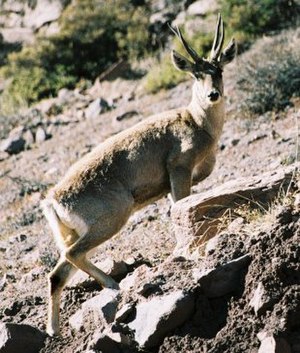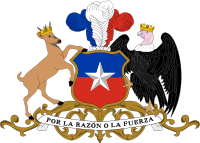Andean deer
| Andean deer | ||||||||||||
|---|---|---|---|---|---|---|---|---|---|---|---|---|

Northern Andean Deer ( Hippocamelus antisensis ) |
||||||||||||
| Systematics | ||||||||||||
|
||||||||||||
| Scientific name | ||||||||||||
| Hippocamelus | ||||||||||||
| Leuckart , 1816 |
The Andean deer ( Hippocamelus ) are in the South American Andes living species of deer (Cervidae). They will also fork deer or Huemuls called (singular Huemul). There are two types:
- The northern Andean deer ( Hippocamelus antisensis ( d'Orbigny , 1834)) lives in Peru , western Bolivia and northern Chile .
- The southern Andean deer ( Hippocamelus bisulcus ( Molina , 1782)) is native to the central and southern regions of Chile and Argentina .
features
Both species are the same size and very similar to each other. Their head body length is 1.4 to 1.65 meters, their shoulder height 78 to 90 centimeters and the weight about 45 to 65 kilograms. The fur is beige-brown in color. The male's antlers are short and form a simple fork. Short legs and a relatively clumsy physique are probably an adaptation to rough high mountain terrain.
The species live in non-overlapping distribution areas, so that a differentiation based on the observation site is certain. Apart from that, the southern Andean deer has a slightly lighter underside and above all a dark underside of the tail; this is white in the northern Andean deer.
habitat
Huemuls are animals of the high mountains. The northern Andean deer in particular, which rises to heights of over 5000 meters in summer, can live at higher altitudes than most other mammals. In winter it moves to lower altitudes by 2500 meters. The southern species, on the other hand, lives all year round at altitudes between 1300 and 1700 meters. You can often find Huemuls on rugged mountain slopes, but also on mountain meadows or in forests.
Way of life
Northern Andean deer are diurnal. They migrate through their habitat in groups of an average of eight animals. These groups seem to have a loose cohesion. Young and old animals of both sexes join them and leave them again. In contrast, the southern species shows a behavior that is more typical of deer. There are many solitary animals here. Males try to gather around a group of females who they aggressively defend against other males.
Threat and protection
Both species are considered threatened and are listed in Appendix I of the CITES agreement. The IUCN lists the North Andean Deer as endangered ( vulnerable ) and the South Andean deer as endangered . The northern Andean deer is still relatively widespread, but nowhere common. Due to the hunt, its numbers continue to decrease.
The southern Andean deer is particularly threatened by competition from the red deer introduced by humans in Chile . In addition, young animals are killed by feral dogs and the sparse grass is grazed by domestic sheep. The total population is estimated at 1300 animals.
Others

A Huemul is depicted in the Chilean national coat of arms, where he wears a crown. The southern Andean deer is a national symbol of Chile , along with the condor .
Unaware that he belonged to the deer, the Huemul was first described as a hybrid of horse and camel. The scientific name Hippocamelus still comes from this misjudgment today , since a name that has been given once cannot be changed according to the ICZN rules .
literature
- Ronald M. Nowak: Walker's Mammals of the World . Johns Hopkins University Press, 1999 ISBN 0-8018-5789-9
Web links
- Hippocamelus on the IUCN Red List of Threatened Species. Retrieved October 21, 2009.
